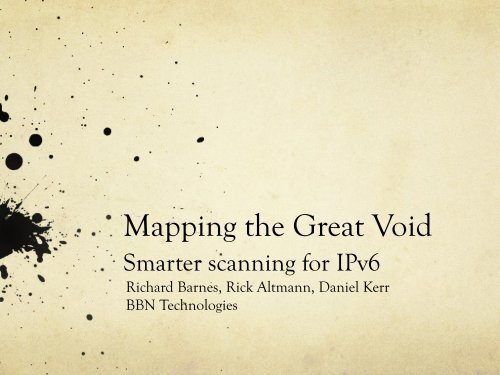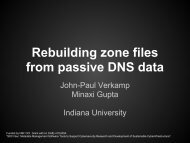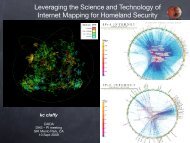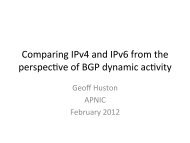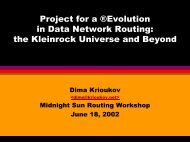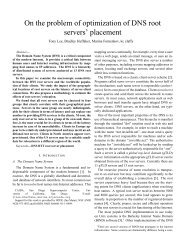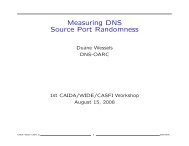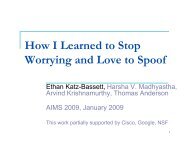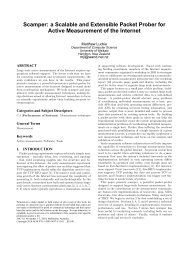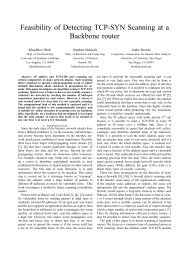Mapping the Great Void: Smarter scanning for IPv6 - Caida
Mapping the Great Void: Smarter scanning for IPv6 - Caida
Mapping the Great Void: Smarter scanning for IPv6 - Caida
You also want an ePaper? Increase the reach of your titles
YUMPU automatically turns print PDFs into web optimized ePapers that Google loves.
<strong>Mapping</strong> <strong>the</strong> <strong>Great</strong> <strong>Void</strong><br />
<strong>Smarter</strong> <strong>scanning</strong> <strong>for</strong> <strong>IPv6</strong><br />
Richard Barnes, Rick Altmann, Daniel Kerr<br />
BBN Technologies
Agenda<br />
! Challenges <strong>for</strong> mapping <strong>the</strong> <strong>IPv6</strong> Internet<br />
! Some approaches to smarter <strong>scanning</strong><br />
! CIDR++<br />
! Registry in<strong>for</strong>mation<br />
! Addressing heuristics<br />
! Empirical results
Background: <strong>IPv6</strong> is big
<strong>IPv6</strong> address space is big<br />
! How do you select <strong>the</strong> networks you trace to?<br />
! Ark IPv4: Each /24 covered by a BGP prefix<br />
! Ark <strong>IPv6</strong>: One per prefix advertised in BGP<br />
! Supposing we view a /48 as functionally similar to a /<br />
24…<br />
! IPv4: 12,577,420 /24s advertised (~2 23.6 )<br />
! <strong>IPv6</strong>: 3,523,931,041 /48s advertised (~2 31.7 )<br />
! … and that’s with <strong>the</strong> current level of <strong>IPv6</strong> deployment<br />
! And really, /48s get subdivided too<br />
http://www.caida.org/workshops/isma/1102/slides/aims1102_yhyun_ark.pdf<br />
RouteViews RIB from WIDE collector, 2011/12/22
General Approach: Adaptive Probing<br />
! Learn from previous rounds of probes to predict where you<br />
should probe next<br />
! In <strong>the</strong> IPv4 context, focus has been on reducing impact of<br />
comprehensive measurement traffic<br />
! DoubleTree / Interface Set Cover algorithms find minimal set<br />
of paths to cover all interfaces<br />
! In <strong>IPv6</strong>, focus is more on discovering <strong>the</strong> most subnets /<br />
interfaces in a feasible number of measurements<br />
! Some algorithms don’t scale to <strong>IPv6</strong> (e.g., subnet-centric)<br />
http://rbeverly.net/research/papers/direct-imc10.pdf<br />
RouteViews RIB from WIDE collector, 2011/12/22
<strong>Smarter</strong> Scanning
Going beyond BGP<br />
! To tell two networks apart in measurements, we need<br />
to trace to a target in each of <strong>the</strong>m<br />
! Finding networks via pure random <strong>scanning</strong> within<br />
BGP-announced prefixes doesn’t scale<br />
! Start with BGP, add more in<strong>for</strong>mation<br />
! Small amounts of randomness<br />
! Registration in<strong>for</strong>mation (WHOIS)<br />
! In<strong>for</strong>mation ga<strong>the</strong>red in earlier scans
Testing Methodology<br />
! 5 nodes from commercial VPS services<br />
! ICMP Paris traceroutes to selected targets<br />
! Metric: Discovered addresses (no alias resolution)
Technique Traceroute<br />
Targets /<br />
Monitor<br />
Baseline: BGP<br />
Monitors Total<br />
Measureme<br />
nts<br />
Discovered<br />
Interface<br />
Addresses<br />
Gain Rate<br />
(New Hops<br />
Per Trace)<br />
BGP 8380 5 41900 16986 0.405
BGP+4<br />
! Some networks do a little bit of subdivision of an<br />
advertised prefix, but maybe not much<br />
! Take each prefix from BGP<br />
! Compute 16 subnets you can get by adding 4 random<br />
bits<br />
! Random <strong>scanning</strong>, but bounded increase in work (16x)
Technique Traceroute<br />
Targets /<br />
Monitor<br />
BGP+4<br />
Monitors Total<br />
Measureme<br />
nts<br />
Discovered<br />
Interface<br />
Addresses<br />
BGP 8380 5 41900 16986 0.405<br />
Gain Rate<br />
(New Hops<br />
Per Trace)<br />
BGP+4 73407 5 367035 20434 0.056
BGP WHOIS + Rand48<br />
! People sometimes register WHOIS in<strong>for</strong>mation at a<br />
higher level of granularity than <strong>the</strong>y advertise in BGP<br />
! Download bulk WHOIS in<strong>for</strong>mation and build a list<br />
of prefixes from inet6num objects<br />
! Find routable WHOIS prefixes, covered by prefixes<br />
advertised in BGP<br />
! If a given BGP prefix has no more specifics in WHOIS,<br />
sample five random /48s
BGP WHOIS + Rand48<br />
Prefix Network BGP Gain<br />
2a02:f8:7:1a::/64 IT AISA-NET-1 /32 32<br />
2a01:4f8:141:22::/64 DE FORMER-03-GMBH /32 32<br />
2406:4800::/64 SG DOCOMOinterTouch-HQ-V6 /40 24<br />
2405:2000:ff10::/56 IN CHN-CXR-TATAC /32 24<br />
2607:f6f0:100::/56 US EQUINIX-EDMA-V6-CORP-01 /40 16<br />
2001:42c8:ffd0:100::/56 ZA CAPETOWN-KLT-TATA /32 24
BGP WHOIS + Rand48<br />
Technique Traceroute<br />
Targets /<br />
Monitor<br />
Monitors Total<br />
Measureme<br />
nts<br />
Discovered<br />
Interface<br />
Addresses<br />
BGP 8380 5 41900 16986 0.405<br />
BGP+4 73407 5 367035 20434 0.056<br />
BGP <br />
WHOIS +<br />
Rand48<br />
90817 4 363268 40074 0.110<br />
Gain Rate<br />
(New Hops<br />
Per Trace)
Sequence Completion<br />
! As we do traceroutes, we get addresses back in <strong>the</strong> source addresses<br />
of responses<br />
! Sometimes <strong>the</strong>se addresses hint at <strong>the</strong> use of addressing schemes<br />
! Look <strong>for</strong> runs within each hex digit, <strong>the</strong>n complete sequences<br />
2001:db8:1:47c8::797f!<br />
2001:db8:1:47c9::47db!<br />
2001:db8:1:47cb::8a03!<br />
2001:db8:1:47cd::4d33!<br />
2001:db8:1:47cf::b221!<br />
2001:db8:1:47c7::/48!<br />
2001:db8:1:47c8::/48!<br />
2001:db8:1:47c9::/48!<br />
2001:db8:1:47ca::/48!<br />
2001:db8:1:47cb::/48!<br />
2001:db8:1:47cc::/48!<br />
2001:db8:1:47cd::/48!<br />
2001:db8:1:47ce::/48!<br />
2001:db8:1:47cf::/48!<br />
2001:db8:1:47d0::/48!
Sequence Completion<br />
BGP<br />
2a01:198::/32<br />
BGP WHOIS<br />
SIXXS-DEDUS01<br />
2a01:198:200::/40<br />
Scanning within <strong>the</strong> /40…<br />
Completing <strong>the</strong> sequence…<br />
2a01:198:200:000::/52!<br />
2a01:198:200:100::/52!<br />
2a01:198:200:200::/52!<br />
2a01:198:200:300::/52!<br />
2a01:198:200:400::/52!<br />
2a01:198:200:500::/52!<br />
2a01:198:200:600::/52!<br />
2a01:198:200:700::/52!<br />
2a01:198:200:800::/52!<br />
2a01:198:200:900::/52!<br />
2a01:198:200:a00::/52!
Sequence Completion<br />
Technique Traceroute<br />
Targets /<br />
Monitor<br />
Monitors Total<br />
Measureme<br />
nts<br />
Discovered<br />
Interface<br />
Addresses<br />
BGP 8380 5 41900 16986 0.405<br />
BGP+4 73407 5 367035 20434 0.056<br />
BGP <br />
WHOIS +<br />
Rand48<br />
Sequence<br />
Completion<br />
90817 4 363268 40074 0.110<br />
Gain Rate<br />
(New Hops<br />
Per Trace)<br />
21279.75 4 85119 22919 0.269
How much did we learn?
Overlap in Discovered Interfaces<br />
Percentage of interfaces<br />
discovered, by source<br />
Circle area proportional to<br />
interface count<br />
Sequence<br />
Completion<br />
29%<br />
BGP+4<br />
8%<br />
0.4%<br />
5%<br />
2%<br />
19%<br />
37%<br />
BGP WHOIS<br />
+ Rand48
Overlap in Discovered Interfaces<br />
26.6% of all discovered<br />
interfaces appeared in<br />
BGP-based traces<br />
Additional techniques<br />
expand coverage ~4x<br />
Sequence<br />
Completion<br />
BGP+4<br />
BGP<br />
BGP WHOIS<br />
+ Rand48
1<br />
0.9<br />
0.8<br />
0.7<br />
0.6<br />
0.5<br />
0.4<br />
0.3<br />
0.2<br />
0.1<br />
0<br />
Broader or Deeper?<br />
! Three techniques show similar hop count distributions<br />
! BGP+WHOIS lower mean, but greater max by 5 hops<br />
CDF of Paris Traceroute Hop Count<br />
1 2 3 4 5 6 7 8 9 10 11 12 13 14 15 16 17 18 19 20 21 22<br />
BGP<br />
BGP+4<br />
BGP+WHOIS<br />
Sequence Completion
Conclusions<br />
! CIDR prefixes derived from BGP hide a lot of topology<br />
in<strong>for</strong>mation<br />
! New techniques add both detail and depth relative to<br />
<strong>scanning</strong> based on BGP prefixes alone<br />
! “Augmented BGP”: BGP+4, BGP+WHOIS<br />
! Inference from discovered addresses<br />
! Each technique seems to cover different parts of <strong>the</strong><br />
network, so combination is necessary<br />
! Future work: Incorporate better algorithms (e.g., ISC)
Digression: Security Appliances<br />
! There are apparently security appliances out <strong>the</strong>re that<br />
respond to ICMP requests <strong>for</strong> every address in a subnet<br />
! Show up in measurements as highly active networks / highly<br />
connected nodes<br />
! May be useful <strong>for</strong> mapping out subnet boundaries<br />
! “20% test” detects with high confidence<br />
! If 2 of 10 randomly chosen addresses within a network respond<br />
to pings …<br />
! … <strong>the</strong>n <strong>the</strong>re’s probably one of <strong>the</strong>se devices <strong>the</strong>re.
Digression: Security Appliances
Thanks!<br />
Richard Barnes<br />
<br />
Rick Altmann<br />
Daniel Kerr


